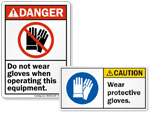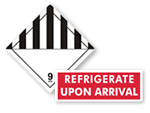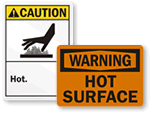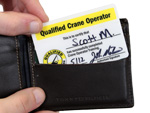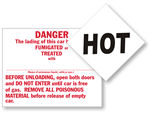Heat waves kill more people than all other natural disasters put together. With temperatures soaring in the upper 90s, heat has become the country's top cause of weather-related deaths. Animals, too, have to bear the brunt. Thousands of cattle in southwestern Kansas died of heat stress due to escalating temperatures, high humidity, and little wind in June 2022.
Heat is a significant cause of workplace injuries because it causes sweaty palms, fogged-up safety glasses, dizziness that may result in falls, and reduced brain function.

A 35-year-old foundry worker succumbed to death due to excessive heat when he was transferred from a relatively cooler area to a warmer job site near ovens and molten metal. Wearing heavy protective clothing and several hours of work resulted in heat stroke and ultimately death. Indoor workers are susceptible to heat illnesses as much as outdoor workers are.
Heat stress may lead to heat-related stroke, heat exhaustion, heat cramps, heat syncope, heat rashes, heat edema, and Rhabdomyolysis, all of which may be deadly. In 2020, the U.S. Bureau of Labor Statistics recorded 1,940 occupational injuries and illnesses involving days away from work and 56 deaths due to exposure to environmental heat.
Not just injuries, productivity also takes a turn. As per the 2018 National Climate Assessment, the cost of lower labor productivity under rising temperatures will reach up to $160,000,000,000 in lost wages per year in the United States by 2090.
What is occupational heat stress?
Occupational heat stress is the net heat load a worker is exposed to through a combination of metabolic heat (physical exertion), environmental factors, and the clothing worn. All of these result in an increase in heat storage in the body.
During heat stress, the body is unable to maintain an optimum temperature in response to a hot environment. According to OSHA, serious heat-related illnesses occur when the body temperature exceeds 100.4°F.
Which employees are more likely to suffer from heat stress?
Workers constantly exposed to high temperatures are more likely to suffer heat stress indoors and outdoors. Most of these employees have long working hours, may not have suitable PPE, or are inadequately trained by their employers to recognize heat illness and measures to prevent heat stress. Firefighters, bakery workers, farmers, construction workers, pool workers, outdoor maintenance workers, miners (particularly surface miners), boiler room workers, mail and package delivery employees, warehouse workers, and iron and steel mill workers are more susceptible to heat illnesses than other workers. Other factors that enhance the chances of heat stress for workers are their age (workers aged 65+ are more vulnerable), high blood pressure, heart disease, general fitness, medical conditions, weight, drug consumption, liquid intake, etc.
How can employers reduce heat-related work injuries?
Mitigating heat exposure risks starts with a well-planned training program. Employers need to conduct heat illness prevention programs at the workplace routinely. This includes proper planning, training, engineering controls, focused heat-prevention practices, and PPE. Some common methods include -
- - Asking and making it normal for employees to take regular breaks in a cooler environment
- - Training workers to identify heat stress and first-aid
- - Adjust work schedule such as assigning heavier work on cooler days
- - Avoid placing high-risk employees in hot work environments for extended time periods
- - Hiring more workers to prevent strain on individual workers
- - Guiding them to drink cool water (59°F)/beverages with electrolytes every 15 minutes
- - Ensuring workers are acclimated before they work in a hot environment
- - Providing appropriate protective clothing
- - Adding first aid stations, safety showers, etc. to provide immediate treatment
- - Increasing air flow and reducing humidity in the work area
What are the immediate steps to treat an employee affected by heat stress?
Quick action will help avoid any long-term damage.
- - Calmly assess the situation of the victim.
- - Transfer the worker to a shaded or cooler area.
- - Remove any outer clothing.
- - Apply ice.
- - Make the worker drink cool water.
- - Attempt to fan or mist the employee.
- - If it is determined that the situation is serious, call 911 and stay with the victim until help arrives.
Employers must create a buddy system for workers so that companion workers bring these cases to immediate attention and take action as quickly as possible. In this system, workers must be familiarized with heat illnesses and stroke symptoms. Or, a supervisor may be designated to monitor conditions and protect workers.

A complete heat illness prevention program also includes using signs that educate workers about heat indexes and risk levels, ultimately preventing heat injuries and fatalities.
Are there any laws on heat prevention for workplaces?
Under OSHA’s General Duty Clause, employers are required to provide a place of employment free from recognized hazards that are causing or likely to cause death or serious harm to employees." This includes heat hazards too, given its potentially dangerous nature. OSHA does mention that an employer with workers exposed to high temperatures should develop a heat illness prevention program.
There is no specific OSHA standard for occupational heat exposure; however, the concern has been addressed in PPE standards, Sanitation standards, Medical Services and First Aid standards, and Construction Standards of OSHA. Workplaces heavily rely on NIOSH’s recommendations on ‘Occupational Exposure to Heat and Hot Environments.’
The following U.S. states implement their separate standards for heat exposure while several others are in rulemaking. For example -
California’s Heat Standard requires employers to provide training, water, shade, and planning if the temperature exceeds 80°F triggers the requirements.
Minnesota Rules 5205.0110 required employees not to expose workers to indoor environmental heat conditions exceeding 86°F, depending on the workload.
In Washington, employers must take steps to prevent heat-related illnesses when outdoor temperatures reach:
52° F – Workers wearing non-breathable clothing
77° F – Workers wearing double-layer woven clothing
89° F – Regardless of clothing type.
Not just in occupations, but heat advisories, excessive heat warnings, and heat watches are issued by the weather department (the weather reports can be useful but may not reflect the conditions at the specific worksite). But depending on many factors, the heat indexes are set differently for different states like -
The state gets a Heat Advisory issued by the weather services at a heat index of 95-104 °F. Excessive Heat Warning as the temperature crosses 105 °F.
The weather department issues Heat Advisory at a heat index of 100-104 °F in individual counties of the state. Advisory forms a basis for actions on no evictions, no turning off of power, changing outdoor work requirements, etc.
What is WBGT? What role does it play in assessing workplace environmental heat?
WBGT is Wet Bulb Globe Temperature, a standard measure that OSHA recommends for monitoring workplace environmental heat.
WBGT devices contain three different thermometers:
- - A dry bulb thermometer to calculate the ambient air temperature.
- - A natural wet-bulb thermometer to measure the potential for evaporative cooling.
- - A black globe thermometer to measure radiant heat.
The WBGT instrument should be placed close to the work site. For example, the WBGT instrument should be in the sun if the work is in direct sunlight.
Unlike heat index monitors, WBGT takes into account all four major environmental heat factors — temperature, humidity, radiant heat, and wind — that influence the total heat stress experienced by workers.
NIOSH publishes recommended occupational heat exposure limits based on environmental heat (measured as wet bulb globe temperature [WBGT]) and metabolic heat (i.e., workload). According to a report, among the 25 outdoor occupational heat-related illnesses investigated by OSHA from 2011 to 2016, WBGT-based occupational exposure limits exceeded all 14 fatalities and 8 of 11 nonfatal illnesses. Six fatalities occurred when the Heat Index was ?91°F (32.8°C).
Are employers liable to compensate for heat-related injuries/illnesses?
Yes, workers’ compensation benefits are based on state law. During a safety inspection, an OSHA citation is issued if the employer fails to protect workers from recognized hazards such as heat-related illnesses. Usually, employees who sustain a heat-related work injury or illness are entitled to workers’ compensation benefits covering medical expenses like -
- - Initial doctor’s visit
- - Follow-up visits
- - Physical therapy
- - prescription costs
- - Rehabilitation expenses
In addition, if heat stroke causes you to miss work, your employer should pay you a percentage of your wages until you’re able to return to employment. If the employee suffers disability of any kind, he or she may be entitled to receive up to two-thirds of their average gross weekly wages during the recovery period, subject to a maximum set rate. It is best to look up individual state laws (Department of Labor and Industry) for the exact compensation if any.
How do signs help in preventing heat stress injuries?
Signs can effectively remind workers that high temperatures can be hazardous and precautions must be taken. Different kinds of signs and tools useful across workplaces are -
Wallet cards

Heat Safety Wallet Cards are a handy way to provide detailed information on heat stress symptoms and prevention methods.
Heat Index Calculator and Indicator

HeatAlert is a heat index monitoring and alerting system that flashes LED lights to indicate moderate (91 to 103 °F) and high heat risk (more than 103°F).
PPE signs

PPE Signs remind workers to wear proper PPE. Workers can wear personal cooling systems like water-cooled garments, air-cooled garments, cooling vests, and wetted overgarments instead of clothing that hold in excess heat and moisture, making the worker’s body even hotter.














